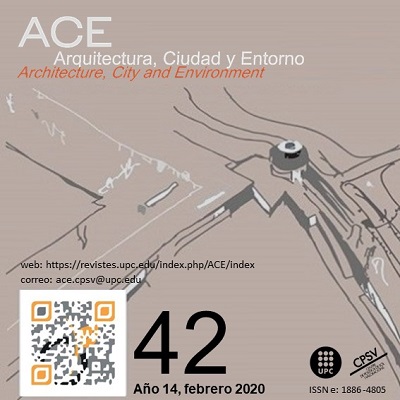L'envoltant en la rehabilitació de conjunts d'habitatge protegit
DOI:
https://doi.org/10.5821/ace.14.42.8960Paraules clau:
Edificació, eficiència, patrimoni, Caño RotoResum
En aquest article es tracta la renovació de l'envoltant de l'edificació residencial en conjunts urbans d'habitatge protegit construïts entre els anys quaranta i setanta de segle XX. L'estat i funcionament de l'envoltant d'aquesta edificació vulnerable condicionen la seva estabilitat, habitabilitat, eficiència energètica i identitat arquitectònica, amb el seu efecte en el desenvolupament equilibrat de la ciutat. La investigació se centra en una de les primeres rehabilitacions integrals que s'han completat amb un abast territorial a Espanya, la desenvolupada en el Poblat Dirigit de Caño Roto, Madrid, entre els anys 1994 i 2004. La metodologia utilitzada planteja un detallat anàlisi qualitativa i quantitatiu de l'adequació funcional de l'envoltant tèrmica en el moment previ a la rehabilitació, que dóna lloc a un diagnòstic, i en el moment actual, que permet avaluar el resultat. Els dos estats s'estructuren en funció dels tancaments de coberta, façana i sòl, segons la definició que fa d'envolvent tèrmica el Codi Tècnic de l'Edificació i aplicant els seus barems per obtenir una avaluació objectiva i actual. L'estudi sistemàtic de la intervenció en l'envolupant constata que el procés de rehabilitació ha aconseguit uns paràmetres òptims, que contribueixen a la renovació de parc edificatori a escala urbana, però suposa l'alteració de la seva imatge amb la consegüent pèrdua de valor patrimonial o interès arquitectònic . Aquest resultat porta a qüestionar les pautes i principis d'aquestes operacions, que per la seva relativa novetat no compten amb una normativa pròpia.
Descàrregues
Publicades
Número
Secció
Llicència
| CRITERIS DE PROTECCIÓ INTEL·LECTUAL |
En aquest moment es compta amb la protecció de la Oficina Espanyola de Patents i Marques, mentre que la protecció global s'està tramitant davant la Organització Mundial de la Propietat Intel·lectual (OMPI/WIPO). Així mateix, la Oficina del Número de Sèrie Estàndar Internacional (ISSN) ha otorgat els següents números: 1886-4805 (versió electrònica) i 1887-7052 (versió en paper). |
| COPYRIGHT |
El contingut dels articles i els comentaris en ells expresats són responsabilitat exclusiva dels seus actors, i no reflexen necessariament la opinió del Comité Editor de la revista. Els treballs publicats per ACE queden sotmesos a la llicència CC BY-NC-ND 3.0 ES http://creativecommons.org/licenses/by-nc-nd/3.0/es/ La qual cosa vol dir que les persones autores només tenen i retenen els drets d'autor dintre de les limitacions imposades per la anterior llicència |


































